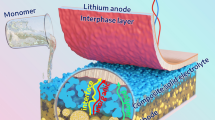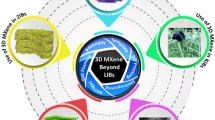Abstract
Molybdenum disulfide (MoS2) is a promising anode material for lithium ion batteries (LIBs) due to its high theoretical capacity, but it is suffered from intrinsically poor electronic/ionic conductivity and vast volume expansion/contraction during repeated charge–discharge process. In the present work, we report a spherical C@MoS2 nanocomposite as a high-performance anode for LIBs. The C@MoS2 nanocomposite with carbon nanosphere cores and ultrathin MoS2 nanosheet shells was prepared through an in situ solvothermal reaction, where carbon and MoS2 were simultaneously formed in one pot. The basal plane of MoS2 layer is highly parallel to the surface of carbon sphere, constructing a concentric nanostructure. This unique architecture can provide strong and stable interfacial contact between the MoS2 nanosheets and carbon and thus improve its structural stability and maximize the electrical contact. Owing to the effective combination and synergistic interaction of the two nanoscale phases, the C@MoS2 nanocomposite exhibited markedly enhanced performance with high rate capability and cycle stability for reversible Li+ storage.






Similar content being viewed by others
References
Benavente E, Santa Ana MA, Mendizabal F, Gonzalez G (2002) Intercalation chemistry of molybdenum disulfide. Coord Chem Rev 224:87–109
Stephenson T, Li Z, Olsen B, Mitlin D (2014) Lithium ion battery applications of molybdenum disulfide (MoS2) nanocomposites. Energy Environ Sci 7:209–231
Xu X, Liu W, Kim Y, Cho J (2014) Nanostructured transition metal sulfides for lithium ion batteries: progress and challenges. Nano Today 9:604–630
Fang X, Guo X, Mao Y, Hua C, Shen L, Hu Y, Wang Z, Wu F, Chen L (2012) Mechanism of lithium storage in MoS2 and the feasibility of using Li2S/Mo nanocomposites as cathode materials for lithium–sulfur batteries. Chem Asian J 7:1013–1017
Chhowalla M, Shin HS, Eda G, Li L-J, Loh KP, Zhang H (2013) The chemistry of two-dimensional layered transition metal dichalcogenide nanosheets. Nat Chem 5:263–275
Wang Q, Li J (2007) Facilitated lithium storage in MoS2 overlayers supported on coaxial carbon nanotubes. J Phys Chem C 111:1675–1682
Wang J-Z, Lu L, Lotya M, Coleman JN, Chou S-L, Liu H-K, Minett AI, Chen J (2013) Development of MoS2-CNT composite thin film from layered MoS2 for lithium batteries. Adv Energy Mater 3:798–805
Lu C, W-w Liu, Li H, Tay BK (2014) A binder-free CNT network-MoS2 composite as a high performance anode material in lithium ion batteries. Chem Commun 50:3338–3340
Chang K, Chen WX (2011) l-cysteine-assisted synthesis of layered MoS2/graphene composites with excellent electrochemical performances for lithium ion batteries. ACS Nano 5:4720–4728
Chang K, Geng D, Li X, Yang J, Tang Y, Cai M, Li R, Sun X (2013) Ultrathin MoS2/nitrogen-doped graphene nanosheets with highly reversible lithium storage. Adv Energy Mater 3:839–844
Kong D, He H, Song Q, Wang B, Lv W, Yang Q-H, Zhi L (2014) Rational design of MoS2@graphene nanocables: towards high performance electrode materials for Lithium ion batteries. Energy Environ Sci 7:3320–3325
Wang J, Liu J, Chao D, Yan J, Lin J, Shen ZX (2014) Self-assembly of honeycomb-like MoS2 nanoarchitectures anchored into graphene foam for enhanced lithium-ion storage. Adv Mater 26:7162–7169
Zhou F, Xin S, Liang H-W, Song L-T, Yu S-H (2014) Carbon nanofibers decorated with molybdenum disulfide nanosheets: synergistic lithium storage and enhanced electrochemical performance. Angew Chem Int Ed 53:11552–11556
Zhu C, Mu X, van Aken PA, Yu Y, Maier J (2014) Single-layered ultrasmall nanoplates of MoS2 embedded in carbon nanofibers with excellent electrochemical performance for lithium and sodium storage. Angew Chem Int Ed 53:2152–2156
Zhou X, Wan L-J, Guo Y-G (2012) Facile synthesis of MoS2@CMK-3 nanocomposite as an improved anode material for lithium-ion batteries. Nanoscale 4:5868–5871
Xu X, Fan Z, Yu X, Ding S, Yu D, Lou XWD (2014) A nanosheets-on-channel architecture constructed from MoS2 and CMK-3 for high-capacity and long-cycle-life lithium storage. Adv Energy Mater 4:1400902
Bazargan A, Yan Y, Hui CW, McKay G (2013) A review: synthesis of carbon-based nano and micro materials by high temperature and high pressure. Ind Eng Chem Res 52:12689–12702
Hu B, Wang K, Wu L, Yu S-H, Antonietti M, Titirici M-M (2010) Engineering carbon materials from the hydrothermal carbonization process of biomass. Adv Mater 22:813–828
Verble JL, Wieting TJ (1970) Lattice mode degeneracy in MoS2 and other layer compounds. Phys Rev Lett 25:362–365
Windom B, Sawyer WG, Hahn D (2011) A raman spectroscopic study of MoS2 and MoO3: applications to tribological systems. Tribol Lett 42:301–310
Wang Y-X, Huang L, Sun L-C, Xie S-Y, Xu G-L, Chen S-R, Xu Y-F, Li J-T, Chou S-L, Dou S-X, Sun S-G (2012) Facile synthesis of a interleaved expanded graphite-embedded sulphur nanocomposite as cathode of Li–S batteries with excellent lithium storage performance. J Mater Chem 22:4744–4750
Cao R, Zhuang Q-C, Tian L-L, Qiu X-Y, Shi Y-L (2014) Electrochemical impedance spectroscopic study of the lithium storage mechanism in commercial molybdenum disulfide. Ionics 20:459–469
Acknowledgements
This work was supported by National Natural Science Foundation of China (No. 21673097).
Author information
Authors and Affiliations
Corresponding author
Ethics declarations
Conflict of interest
The authors declare no competing financial interest.
Electronic supplementary material
Below is the link to the electronic supplementary material.
Rights and permissions
About this article
Cite this article
Li, N., Liu, Z., Gao, Q. et al. In situ synthesis of concentric C@MoS2 core–shell nanospheres as anode for lithium ion battery. J Mater Sci 52, 13183–13191 (2017). https://doi.org/10.1007/s10853-017-1411-0
Received:
Accepted:
Published:
Issue Date:
DOI: https://doi.org/10.1007/s10853-017-1411-0




